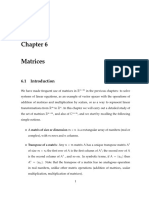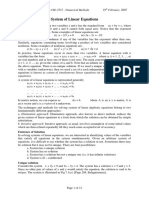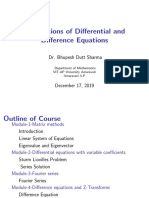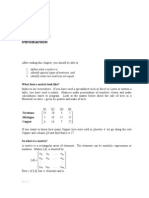Linear Alg Notes
Linear Alg Notes
Uploaded by
Cathy DengCopyright:
Available Formats
Linear Alg Notes
Linear Alg Notes
Uploaded by
Cathy DengOriginal Title
Copyright
Available Formats
Share this document
Did you find this document useful?
Is this content inappropriate?
Copyright:
Available Formats
Linear Alg Notes
Linear Alg Notes
Uploaded by
Cathy DengCopyright:
Available Formats
BRIEF NOTES ON LINEAR ALGEBRA
DAVID M. MCCLENDON
Abstract. A review of some basic ideas of linear algebra necessary for Math
310. Warning: the examples in these notes have not been checked for arith-
metic errors.
1. Matrix vocabulary
A matrix is an array of numbers arranged in a rectangle. A matrix is called
m n if it has m rows and n columns. Throughout these notes we consider only
square matrices, that is, matrices that have the same number of rows as columns;
the set of nn matrices with real entries is called M
n
(R). Matrices will be referred
to with capital letters and their entries will be referred to with lowercase letters
(i.e. a
ij
represents the entry in row i and column j of the matrix A). Entries of
the form a
ii
are the diagonal entries of A. The trace of a matrix is the sum of its
diagonal entries. In these notes, the rows and columns of a matrix are numbered
starting with the number 1, so the left most column is the rst column.
Example: Let A =
_
_
1 2 3
4 5 6
7 8 9
_
_
. Then A M
3
(R) since A has three rows
and columns; we have a
13
= 3, a
32
= 8, etc.; the diagonal entries of A are 1, 5 and
9, so the trace of A is 1 + 5 + 9 = 15. The second row of A is 4, 5, 6. The entries
above the diagonal of A are 2, 3, 6; the entries below the diagonal are 4, 7, 8.
The letter I always refers to the identity matrix which has diagonal entries equal
to 1 and all other entries 0. The identity matrix is an example of a diagonal matrix,
which is any matrix which has only non-zero entries other than its diagonal entries.
A matrix is called triangular if either all the entries above the diagonal or all the
entries below the diagonal are zero.
The transpose of a matrix A is denoted A
T
and satises A
T
ij
= A
ji
. So if A is as
above, A
T
=
_
_
1 4 7
2 5 8
3 6 9
_
_
.
2. Determinants
Every square matrix has a magic number associated to it called its determi-
nant. The determinant of a diagonal or triangular matrix is the product of its
diagonal entries. In general, determinant formulas can be found by induction:
Date: April 23, 2008.
1
2 D. MCCLENDON
Proposition 2.1. If A is 2 2, i.e. A =
_
a b
c d
_
, then det(A) = ad bc.
Proposition 2.2. If A is 3 3, i.e. if A =
_
_
a b c
d e f
g h i
_
_
, then
det(A) = aei + bfg + cdh (ceg + afh + bdi).
For any size matrix, the determinant can be found using minors.
Denition 2.1. Given an nn square matrix A and an entry a
ij
of A, the minor
A
ij
is the (n 1) (n 1) matrix obtained by deleting the i
th
row and j
th
column
of A.
The method of using minors to nd determinants relies on the following facts:
Proposition 2.3. For any j, det(A) =
n
i=1
(1)
i+j
a
ij
det(A
ij
)
Proposition 2.4. For any i, det(A) =
n
j=1
(1)
i+j
a
ij
det(A
ij
).
and is best illustrated in an example:
Example: Find the determinant of A =
_
_
_
_
1 2 1 0
2 0 1 1
1 1 0 1
0 1 0 2
_
_
_
_
.
Solution: First, pick a row or column of A (preferably one that has several zeros
in it). I will pick the third column. Now what I will do is move down that column
entry by entry and for each entry, nd the minor of that entry. In particular, the
minor of entries a
13
= 1 and a
23
= 1 are
A
13
=
_
_
2 0 1
1 1 1
0 1 2
_
_
and A
23
=
_
_
1 2 0
1 1 1
0 1 2
_
_
.
and the determinants of these matrices are 5 and 1, respectively. Now use
Proposition 2.3 with j = 3. We have
det(A) =
4
i=1
(1)
i+3
a
i3
det(A
i3
)
= (1) det(A
13
) (1) det(A
23
) + 0 det(A
33
) 0 det(A
43
)
= (1)(5) (1)(1) + 0 = 6.
3. Eigenvalues and eigenvectors
Denition 3.1. Given A M
n
(R), a nonzero vector x R
n
is called an eigenvec-
tor of A if there is some number R such that Ax = x. Given an eigenvalue
of A, the set of vectors x which satisfy Ax = x of A is called the eigenspace of
A. The multiplicity of an eigenvalue is the dimension of its eigenspace.
Eigenvalues are found using the following propositions:
Proposition 3.1. is an eigenvalue of A if and only if det(I A) = 0.
Proposition 3.2. The sum of the eigenvalues (counting multiplicities) of a matrix
is the trace of that matrix, and the product of the eigenvalues (counting multiplici-
ties) is the determinant of the matrix.
BRIEF NOTES ON LINEAR ALGEBRA 3
Example: Find the eigenvalues and eigenvectors of A =
_
_
0 1 1
1 1 1
1 2 0
_
_
.
Solution: First, solve det(I A) = 0:
det(I A) = det
_
_
1 1
1 1 1
1 2
_
_
=
2
( 1) 1 + 2 + ( 1) 2
=
3
2
2;
setting this equal to zero and solving for we see = 0, = 2 and = 1 are
the eigenvalues. This makes sense because these numbers sum to 1 which is the
trace of A. To nd an eigenvector for each eigenvalue solve Ax = x for a nonzero
x = (a, b, c). For example, for = 2 we have
Ax = x
_
_
_
b c = 2a
a + b + c = 2b
a + 2b = 2c
which has as one of its nonzero solutions x = (a, b, c) = (0, 1, 1). Similarly, an
eigenvector for = 0 is x = (2, 1, 1) and an eigenvector for = 1 is x =
(3, 2, 1).
4. Inverses
A square matrix A is called invertible if there is another matrix A
1
(called the
inverse of A) such that AA
1
= A
1
A = I. It can be shown that an n n square
matrix is invertible if and only if det(A) = 0 if and only if 0 is not an eigenvalue of
A.
Proposition 4.1. The inverse of a diagonal matrix A, if it exists, is diagonal and
has entries which are the reciprocals of the entries of A.
Proposition 4.2. The inverse of a 2 2 matrix A =
_
a b
c d
_
, if it exists, is
A
1
=
1
adbc
_
d b
c a
_
.
To nd the inverse of a larger matrix, use one of two methods. The rst method
is to take the matrix A and form an n2n matrix by writing a copy of the identity
next to it. Then perform row operations until the identity appears in the position
originally occupied by A; the matrix in the position of the identity is A
1
.
Example: Find the inverse of A =
_
_
1 2 1
2 2 4
1 3 3
_
_
.
Solution: First write the matrix (A|I) =
_
_
1 2 1 1 0 0
2 2 4 0 1 0
1 3 3 0 0 1
_
_
. Next
perform row operations on this matrix to turn the left half of the matrix into the
identity (these row operations are the same operations you would do if you were
performing Gaussian elimination). The sequence of operations is: subtract 2 times
Row 2 from Row 1, then subtract Row 1 from Row 3, then multiply Row 2 by
4 D. MCCLENDON
(1/2), then subtract Row 2 from Row 3, then add Row 3 to Row 1, then add 3
times Row 3 to Row 2, then subtract 2 times Row 2 from Row 1. You obtain
(I|A
1
) =
_
_
1 0 0 9 3/2 5
0 1 0 5 1 3
0 0 1 2 1/2 1
_
_
so A
1
=
_
_
9 3/2 5
5 1 3
2 1/2 1
_
_
.
The second way to nd the inverse of a matrix is to rst nd the cofactor matrix:
Denition 4.1. The cofactor matrix of a square matrix A M
n
(R) is the n n
matrix cof(A) whose entries are dened by (cof(A))
ij
= (1)
i+j
det(A
ij
) (recall
that A
ij
is a minor of A as dened in the section on determinants).
Proposition 4.3. If A M
n
(R) is invertible, then A
1
=
1
det(A)
(cof(A))
T
.
Example: Find the inverse of A =
_
_
5 3 2
1 0 2
2 1 3
_
_
.
Solution: We use the preceding proposition. First, we nd the cofactor matrix
of A. The 1, 1 entry of this matrix is found by taking the determinant of the
1, 1 minor (which is 2) and multiplying by (1)
1+1
to obtain a nal answer of 2.
Repeating this procedure for all the entries, we see
cof(A) =
_
_
2 1 1
7 11 1
6 8 3
_
_
.
Observe also that det(A) = 12 2 + 10 + 9 = 5 so
A
1
=
1
det(A)
(cof(A))
T
=
1
5
_
_
2 7 6
1 11 8
1 1 3
_
_
.
5. Diagonalization
Denition 5.1. A square matrix A M
n
(R) is similar to a second matrix B
M
n
(R) if there exists an invertible matrix S M
n
(R) such that A = SBS
1
. A
square matrix A M
n
(R) is called diagonalizable if it is similar to a diagonal
matrix.
Proposition 5.1. A M
n
(R) is diagonalizable if and only if it has n linearly
independent eigenvectors; in this case A = SS
1
where is a diagonal matrix
whose diagonal entries are the eigenvalues of A and S is a matrix whose columns
are the eigenvectors of A (arranged in the same order as their respective eigenvalues
are arranged in ).
So to diagonalize a matrix, you rst nd the eigenvalues and eigenvectors; this
tells you the matrices and S. Then nd S
1
using methods of the previous
section.
Department of Mathematics, Northwestern University, Evanston, IL 60208-2370
E-mail address: dmm@math.northwestern.edu
You might also like
- CH 05Document6 pagesCH 05Saif BaneesNo ratings yet
- Mathematical FundamentalsDocument13 pagesMathematical Fundamentalsjeygar12No ratings yet
- Week 5 Matrices & Determinant IIDocument8 pagesWeek 5 Matrices & Determinant IIfolarintitilolaNo ratings yet
- Matrices and Linear AlgebraDocument13 pagesMatrices and Linear AlgebraRaulNo ratings yet
- Notes On Matric AlgebraDocument11 pagesNotes On Matric AlgebraMaesha ArmeenNo ratings yet
- Week 4 PDFDocument14 pagesWeek 4 PDFDPNo ratings yet
- 2matrices Its OperationsDocument27 pages2matrices Its OperationsJoelar OndaNo ratings yet
- M1 Unit-IDocument26 pagesM1 Unit-ISatti jyothi ManikantaReddyNo ratings yet
- Matrices AlgebraDocument10 pagesMatrices Algebrakasparuhov15No ratings yet
- 1.1 Matrix and PropertiesDocument5 pages1.1 Matrix and Propertiesclint_janNo ratings yet
- Review of Basics & Matrices & Operations Review of FormulaeDocument8 pagesReview of Basics & Matrices & Operations Review of Formulaesiddharthsinghnegi90No ratings yet
- Appendix and IndexDocument104 pagesAppendix and IndexkankirajeshNo ratings yet
- DEFINITION: A Matrix Is Defined As An Ordered Rectangular Array of Numbers. TheyDocument10 pagesDEFINITION: A Matrix Is Defined As An Ordered Rectangular Array of Numbers. Theydarshangaikwad912No ratings yet
- Diagonal IzationDocument10 pagesDiagonal IzationMeMu MeMuNo ratings yet
- Math Majorship LinearDocument12 pagesMath Majorship LinearMaybelene NavaresNo ratings yet
- DEFINITION: A Matrix Is Defined As An Ordered Rectangular Array of Numbers. TheyDocument10 pagesDEFINITION: A Matrix Is Defined As An Ordered Rectangular Array of Numbers. Theydarshangaikwad912No ratings yet
- 2 ND, CahpDocument17 pages2 ND, Cahpbereket tekleNo ratings yet
- DeterminantDocument14 pagesDeterminantNindya SulistyaniNo ratings yet
- Zero DeterminantsDocument4 pagesZero DeterminantsMiliyon TilahunNo ratings yet
- 5 System of Linear EquationDocument12 pages5 System of Linear EquationAl Asad Nur RiyadNo ratings yet
- Linear Algebra SolutionsDocument22 pagesLinear Algebra Solutionsjaspreet_xps0% (1)
- MatricesDocument14 pagesMatricesthinkiitNo ratings yet
- Eigen Values, Eigen Vectors - Afzaal - 1Document81 pagesEigen Values, Eigen Vectors - Afzaal - 1syedabdullah786No ratings yet
- Algebra MatricialDocument17 pagesAlgebra MatricialjoelmulatosanchezNo ratings yet
- 1 Topics in Linear AlgebraDocument42 pages1 Topics in Linear AlgebraArlene DaroNo ratings yet
- matrixAlgebraReview PDFDocument16 pagesmatrixAlgebraReview PDFRocket FireNo ratings yet
- Transpose, Determinant and Inverse of MatrixDocument6 pagesTranspose, Determinant and Inverse of MatrixnurulNo ratings yet
- 1 Determinants: A Ab CDDocument10 pages1 Determinants: A Ab CDssNo ratings yet
- Linear Algebra Chapter 3 - DeTERMINANTSDocument24 pagesLinear Algebra Chapter 3 - DeTERMINANTSdaniel_bashir808No ratings yet
- Matrices Dr.s.s.chauhanDocument22 pagesMatrices Dr.s.s.chauhanQadirNo ratings yet
- Reminding Matrices and DeterminantsDocument6 pagesReminding Matrices and DeterminantsFredrick MutungaNo ratings yet
- Maths 2 For Eng - Lesson 1Document9 pagesMaths 2 For Eng - Lesson 1Abdulkader TukaleNo ratings yet
- NA 5 LatexDocument45 pagesNA 5 LatexpanmergeNo ratings yet
- Section 3.3. Matrix Rank and The Inverse of A Full Rank MatrixDocument13 pagesSection 3.3. Matrix Rank and The Inverse of A Full Rank Matrixnourhan yousefNo ratings yet
- Engineering Mathematics Iii: KNF 2033 Semester 1 2011/2012Document30 pagesEngineering Mathematics Iii: KNF 2033 Semester 1 2011/2012tulis88No ratings yet
- Linear Algebra and Matrix Theory: Part 4 - Eigenvalues and EigenvectorsDocument8 pagesLinear Algebra and Matrix Theory: Part 4 - Eigenvalues and EigenvectorscrazynupNo ratings yet
- Nda Ex: Study MaterialformathsDocument7 pagesNda Ex: Study MaterialformathsMangsuan mungcheshamNo ratings yet
- Linear Algebra - Module 1Document52 pagesLinear Algebra - Module 1TestNo ratings yet
- Unit 2 MatricsDocument37 pagesUnit 2 MatricsAnkit YadavNo ratings yet
- Various Types of Matrices: DeterminantDocument5 pagesVarious Types of Matrices: DeterminantFarid HossainNo ratings yet
- WEEK 5-StudentDocument47 pagesWEEK 5-Studenthafiz patahNo ratings yet
- Mathematics (Introduction To Linear Algebra)Document36 pagesMathematics (Introduction To Linear Algebra)shilpajosephNo ratings yet
- Determinant of A MatrixDocument4 pagesDeterminant of A MatrixAhmed Mohammed SallamNo ratings yet
- Matrices, Determinant and InverseDocument12 pagesMatrices, Determinant and InverseRIZKIKI100% (1)
- Mathematics II-matricesDocument52 pagesMathematics II-matricesBagus RizalNo ratings yet
- Definition of A MatrixDocument8 pagesDefinition of A MatrixAma RahmahNo ratings yet
- Systems and MatricesDocument15 pagesSystems and MatricesTom DavisNo ratings yet
- WIN (2019-20) MAT1002 ETH AP2019205000028 Reference Material I Application of ODE PDFDocument177 pagesWIN (2019-20) MAT1002 ETH AP2019205000028 Reference Material I Application of ODE PDFEswar RcfNo ratings yet
- Matrices and DeterminantDocument41 pagesMatrices and DeterminantAs NodtNo ratings yet
- Lecture7 D2 PDFDocument25 pagesLecture7 D2 PDFParitosh GuptaNo ratings yet
- LA - 2. Matrix Algebra - StudentsDocument95 pagesLA - 2. Matrix Algebra - StudentsNhat AnhNo ratings yet
- Mathematics of Modern Engineering I Lecture 4Document6 pagesMathematics of Modern Engineering I Lecture 4lzgcd99No ratings yet
- Chapter 3 Lae1Document27 pagesChapter 3 Lae1razlan ghazaliNo ratings yet
- Linear AlgebraDocument36 pagesLinear Algebrarajesh.shirwal382No ratings yet
- Chapter 2 - Matrix AlgebraDocument89 pagesChapter 2 - Matrix AlgebraCao Bằng Thảo NguyênNo ratings yet
- Matrix NotesDocument23 pagesMatrix NotespsnspkNo ratings yet
- Things To Know PDFDocument7 pagesThings To Know PDFJohn ChenNo ratings yet
- 2-Matrices and DeterminantsDocument42 pages2-Matrices and DeterminantsslowjamsNo ratings yet
- Matrix Theory and Applications for Scientists and EngineersFrom EverandMatrix Theory and Applications for Scientists and EngineersNo ratings yet
- CH 3 Matrices Multiple Choice Questions With AnswersDocument3 pagesCH 3 Matrices Multiple Choice Questions With Answersrahul100% (1)
- Induction MatrixDocument47 pagesInduction MatrixSanjana KalanniNo ratings yet
- Advanced Engineering Systems in Motion:: Dynamics of Three Dimensional (3D) MotionDocument8 pagesAdvanced Engineering Systems in Motion:: Dynamics of Three Dimensional (3D) MotionSagnik Chakraborty0% (1)
- Practice Paper (XIIMathematics)Document190 pagesPractice Paper (XIIMathematics)a4776847719No ratings yet
- Invertible Matrix: Nondegenerate) If There Exists An N-By-N Matrix B Such ThatDocument8 pagesInvertible Matrix: Nondegenerate) If There Exists An N-By-N Matrix B Such ThatAmira SabNo ratings yet
- Business - Maths Cha - 2Document30 pagesBusiness - Maths Cha - 2Bereket ZerihunNo ratings yet
- OrthogonalityDocument28 pagesOrthogonalityBelsty Wale KibretNo ratings yet
- Problem 11: Jordan Canonical FormDocument2 pagesProblem 11: Jordan Canonical Formbassam abutraabNo ratings yet
- Chapter Five: Systems of Linear Algebric EquationsDocument125 pagesChapter Five: Systems of Linear Algebric EquationsGirmole WorkuNo ratings yet
- 3 FDB 5Document3 pages3 FDB 5KOMAL AGGARWALNo ratings yet
- Matrices: CE 310: Advanced Engineering Math For CE Engr. Aldrin Bangud 12Document15 pagesMatrices: CE 310: Advanced Engineering Math For CE Engr. Aldrin Bangud 12Rhey LuceroNo ratings yet
- Course-Lecture-Wise-Plan Linear Algebra NewDocument6 pagesCourse-Lecture-Wise-Plan Linear Algebra NewRamzan MustafaNo ratings yet
- Topic: Matrix Addition and SubtractionDocument6 pagesTopic: Matrix Addition and SubtractionAnonyNo ratings yet
- Matrix and DeterminantDocument7 pagesMatrix and DeterminantMd. Sajid Iqbal Hridoy100% (1)
- Matrices in Power SystemsDocument4 pagesMatrices in Power SystemsMohamed ElsirNo ratings yet
- Matrices NotesDocument3 pagesMatrices Notesvishnusontha75No ratings yet
- Homogeneous CoordinatesDocument14 pagesHomogeneous CoordinatesAjad AliNo ratings yet
- Assignment 6 MTH113Document2 pagesAssignment 6 MTH113TigerNo ratings yet
- Tutorial Sheet 1-1Document2 pagesTutorial Sheet 1-1Samarth AggarwalNo ratings yet
- NutshellDocument7 pagesNutshellIvanNo ratings yet
- CAPE PURE MATHEMATICS UNIT 2 MatrixDocument17 pagesCAPE PURE MATHEMATICS UNIT 2 MatrixChinaidine Petit-FrereNo ratings yet
- Linear Algebra Bscs (Semester ) : Lecture# 03 April 15, 2021 Section - E2 Amna Tahir GCU, LahoreDocument20 pagesLinear Algebra Bscs (Semester ) : Lecture# 03 April 15, 2021 Section - E2 Amna Tahir GCU, LahoreMateenNo ratings yet
- Dot Product and Cross ProductDocument4 pagesDot Product and Cross ProductAra Mae MinaNo ratings yet
- MAE 200A - Homework Set #1Document2 pagesMAE 200A - Homework Set #1vsauerNo ratings yet
- 15 462 Fall03 WrAssign1 AnswerDocument5 pages15 462 Fall03 WrAssign1 AnswerBayu Yudha PratamaNo ratings yet
- Time Complexity of Matrix Transpose Algorithm Using Identity Matrix As Reference MatrixDocument2 pagesTime Complexity of Matrix Transpose Algorithm Using Identity Matrix As Reference MatrixPrateek YadavNo ratings yet
- Introduction To Matrix AlgebraDocument98 pagesIntroduction To Matrix Algebrafathi123No ratings yet
- Affine TransformationsDocument8 pagesAffine TransformationsTedi KaNo ratings yet
- Chap 1 LinearAlgebra ECDocument21 pagesChap 1 LinearAlgebra ECMidhun BabuNo ratings yet

























































































